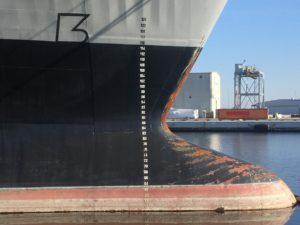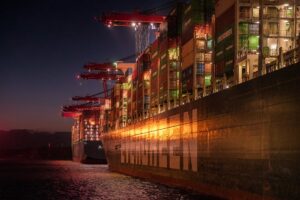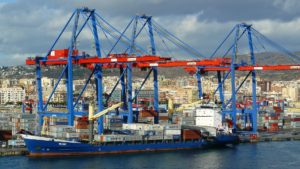Sometimes, the U.S. legislative system does great things. The Inflation Reduction Act that was introduced the week of July 27, 2022 and signed into law on August 16, 2022 is one such example. Reading and deciphering this congressional language is a pain, so to save people some time, below I’ve pulled out the sections relevant for maritime decarbonization. If I missed anything, please let me know.
The full text of the Inflation Reduction Act in all its verbose splendor can be found here.
Environmental Protection Agency
SEC. 60102. GRANTS TO REDUCE AIR POLLUTION AT PORTS
The Clean Air Act is amended by inserting after section 132 of such Act, as added by section 60101 of this Act, the following:
SEC. 133. GRANTS TO REDUCE AIR POLLUTION AT PORTS.
(a) APPROPRIATIONS.—
(1) GENERAL ASSISTANCE.—In addition to amounts otherwise available, there is appropriated to the Administrator for fiscal year 2022, out of any money in the Treasury not otherwise appropriated, $2,250,000,000, to remain available until September 30, 2027, to award rebates and grants to eligible recipients on a competitive basis—
(A) to purchase or install zero-emission port equipment or technology for use at, or to directly serve, one or more ports;
(B) to conduct any relevant planning or permitting in connection with the purchase or installation of such zero-emission port equipment or technology; a
(C) to develop qualified climate action plans.
(2) NONATTAINMENT AREAS.—In addition to amounts otherwise available, there is appropriated to the Administrator for fiscal year 2022, out of any money in the Treasury not otherwise appropriated, $750,000,000, to remain available until September 30, 2027, to award rebates and grants to eligible recipients to carry out activities described in paragraph (1) with respect to ports located in air quality areas designated pursuant to section 107 as non-attainment for an air pollutant.
(b) LIMITATION.—Funds awarded under this section shall not be used by any recipient or subrecipient to purchase or install zero-emission port equipment or technology that will not be located at, or directly serve, the one or more ports involved.
(c) ADMINISTRATION OF FUNDS.—Of the funds made available by this section, the Administrator shall reserve 2 percent for administrative costs necessary to carry out this section.
(d) DEFINITIONS.—In this section:
(1) ELIGIBLE RECIPIENT.—The term ‘eligible recipient’ means—
(A) a port authority;
(B) a State, regional, local, or Tribal agency that has jurisdiction over a port authority or a port;
(C) an air pollution control agency; or
(D) a private entity (including a nonprofit organization) that—
(i) applies for a grant under this section in partnership with an entity described in any of subparagraphs (A) through (C); and
(ii) owns, operates, or uses the facilities, cargo-handling equipment, transportation equipment, or related technology of a port.
(2) GREENHOUSE GAS.—The term ‘greenhouse gas’ has the meaning given the term in section 211(o)(1)(G) (as in effect on the date of enactment of this section).
(3) QUALIFIED CLIMATE ACTION PLAN.—The term ‘qualified climate action plan’ means a detailed and strategic plan that—
(A) establishes goals, implementation strategies, and accounting and inventory practices (including practices used to measure progress toward stated goals) to reduce emissions at one or more ports of—
(i) greenhouse gases;
(ii) an air pollutant that is listed pursuant to section 108(a) (or any precursor to such an air pollutant); and
(iii) hazardous air pollutants;
(B) includes a strategy to collaborate with, communicate with, and address potential effects on stakeholders that may be affected by implementation of the plan, including low-income and disadvantaged near-port communities; and
(C) describes how an eligible recipient has implemented or will implement measures to increase the resilience of the one or more ports involved, including measures related to withstanding and recovering from extreme weather events.
(4) ZERO EMISSION PORT EQUIPMENT OR TECHNOLOGY — The term ‘zero-emission port equipment or technology’ means human-operated equipment or human-maintained technology that—
(A) produces zero emissions of any air pollutant that is listed pursuant to section 108(a) (or any precursor to such an air pollutant) and any greenhouse gas other than water vapor; or
(B) captures 100 percent of the emissions described in subparagraph (A) that are produced by an ocean-going vessel at berth.’’.
National Oceanic and Atmospheric Administration
SEC. 40001. INVESTING IN COASTAL COMMUNITIES AND CLIMATE RESILIENCE
(a) IN GENERAL.— In addition to amounts otherwise available, there is appropriated to the National Oceanic and Atmospheric Administration for fiscal year 2022, out of any money in the Treasury not otherwise appropriated, $2,600,000,000, to remain available until September 30, 2026, to provide funding through direct expenditure, contracts, grants, cooperative agreements, or technical assistance to coastal states (as defined in paragraph (4) of section 304 of the Coastal Zone Management Act of 1972 (16 U.S.C. 1453(4))), the District of Columbia, Tribal, Governments, nonprofit organizations, local governments, and institutions of higher education (as defined in sub-section (a) of section 101 of the Higher Education Act of 1965 (20 U.S.C. 1001(a))), for the conservation, restoration, and protection of coastal and marine habitats and resources, including fisheries, to enable coastal communities to prepare for extreme storms and other changing climate conditions, and for projects that support natural resources that sustain coastal and marine resource dependent communities, and for related administrative expenses.
Department of Energy
SEC. 13502. ADVANCED MANUFACTURING PRODUCTION CREDIT
(a) IN GENERAL.— Subpart D of part IV of subchapter A of chapter 1, as amended by the preceding provisions of this Act, is amended by adding at the end the following new section:
SEC. 45X. ADVANCED MANUFACTURING PRODUCTION CREDIT.
(b) CREDIT AMOUNT.—
(1) IN GENERAL.—Subject to paragraph (3), the amount determined under this subsection with respect to any eligible component, including any eligible component it incorporates, shall be equal to —
(F) in the case of a wind energy component —
(i) if such component is a related offshore wind vessel, an amount equal to 10 percent of the sales price of such vessel, and
(ii) if such component is not described in clause (i), an amount equal to the product of—
(c) DEFINITIONS.—For purposes of this section—
(4) WIND ENERGY COMPONENT.—
(A) IN GENERAL.—The term ‘wind energy component’ means any of the following:
(i) Blades.
(ii) Nacelles
(iii) Towers
(iv) Offshore wind foundations
(v) Related offshore wind vessels
(B) ASSOCIATED DEFINITIONS.—
(iv) RELATED OFFSHORE WIND VESSEL.—The term ‘related offshore wind vessel’ means any vessel which is purpose-built or retrofitted for purposes of the development, transport, installation, operation, or maintenance of offshore wind energy components.
SEC. 50141. FUNDING FOR DEPARTMENT OF ENERGY LOAN PROGRAMS OFFICE
(a) COMMITMENT AUTHORITY—In addition to commitment authority otherwise available and previously provided, the Secretary may make commitments to guarantee loans for eligible projects under section 1703 of the Energy Policy Act of 2005 (42 S.C. 16513), up to a total principal amount of $40,000,000,000, to remain available through September 30, 2026.
(b) APPROPRIATION.— In addition to amounts otherwise available and previously provided, there is appropriated to the Secretary for fiscal year 2022, out of any money in the Treasury not otherwise appropriated, $3,600,000,000, to remain available through September 30, 2026, for the costs of guarantees made under section 1703 of the Energy Policy Act of 2005 (42 U.S.C. 16513), using the loan guarantee authority provided under sub-section (a) of this section.
NOTE – While there is no explicit mention of maritime within the LPO section of the Inflation Reduction Act , the relevancy here is that this LPO program can fund low-emission vessels or other maritime decarbonization projects if you read the language in the links above.
SEC. 50142. ADVANCED TECHNOLOGY VEHICLE MANUFACTURING (ATVM)
(a) APPROPRIATION.—In addition to amounts otherwise available, there is appropriated to the Secretary for fiscal year 2022, out of any money in the Treasury not otherwise appropriated, $3,000,000,000, to remain available through September 30, 2028, for the costs of providing direct loans under section 136(d) of the Energy Independence and Security Act of 2007 (42 U.S.C.17013(d)): Provided, That funds appropriated by this section may be used for the costs of providing direct loans for reequipping, expanding, or establishing a manufacturing facility in the United States to produce, or for engineering integration performed in the United States of, advanced technology vehicles described in subparagraph (C),20(D), (E), or (F) of section 136(a)(1) of such Act (42 U.S.C. 17013(a)(1)) only if such advanced technology vehicles emit, under any possible operational mode or condition, low or zero exhaust emissions of greenhouse gases.
NOTE – While there is no explicit mention of maritime within the LPO section of the Inflation Reduction Act , the relevancy here is that this program within LPO was authorized through the Bipartisan Infrastructure Law to include maritime vessels within the scope of the ATVM, so low-emission vessels are eligible here as well.




